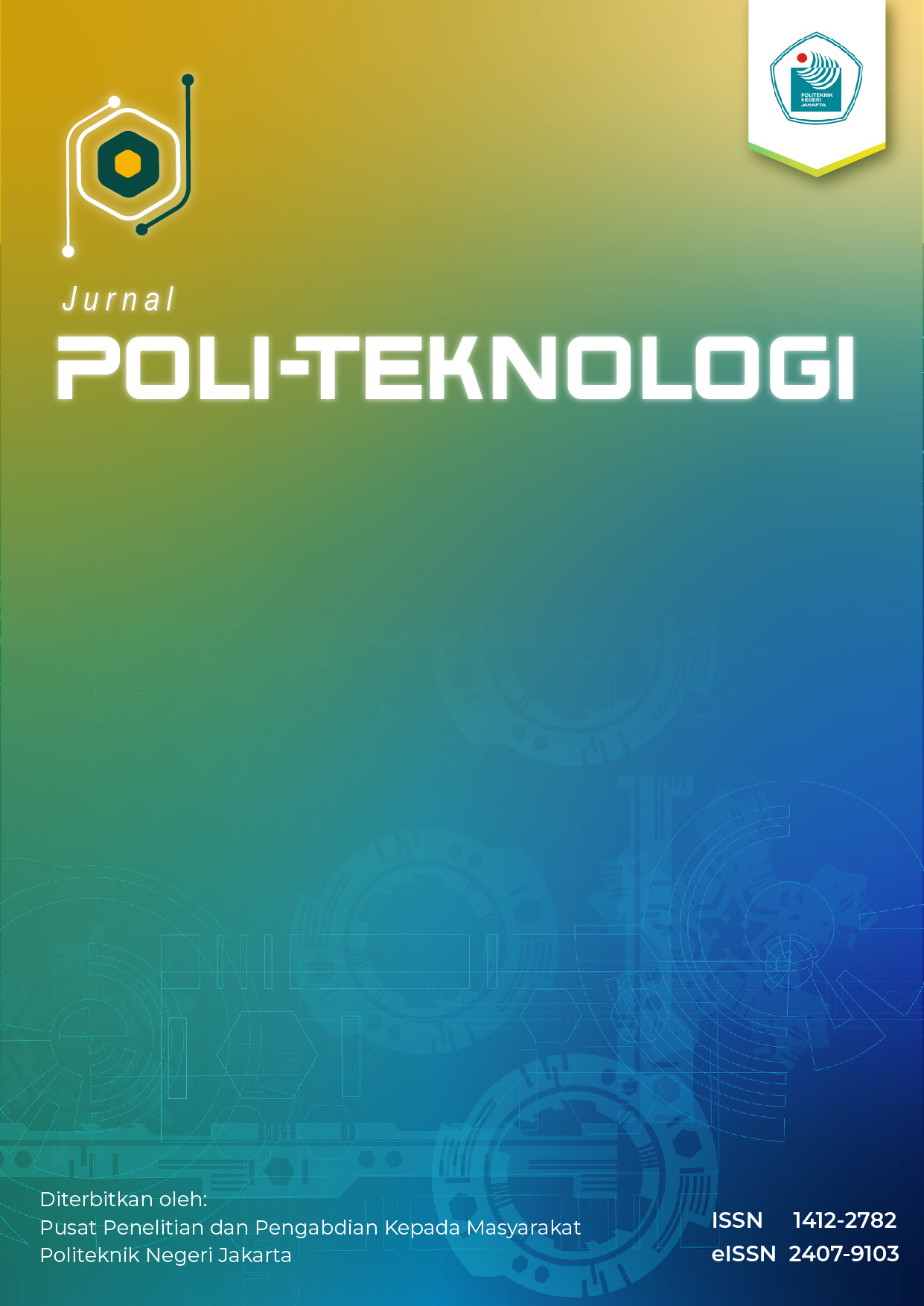Evaluation of the Use of Fine Aggregates of Quartz Sand and Fly Ash in Geopolymer Concrete Based on Potassium Hydroxide Binder on the Compressive Strength and Absorbency of Concrete
DOI:
https://doi.org/10.32722/pt.v23i1.6037Abstract
The development of concrete construction has the impact of increasing cement production and
damaging the balance of nature because every 1kg of cement production produces CO2 emissions
of 0.5 - 0.7 kg. To reduce this iMPact, geopolymer concrete innovation was formed. Geopolymer
concrete is formed from the polymerization reaction of silica (Si) and alumina (Al) compounds
found in quartz sand and fly ash waste from burning coal which has binding properties like cement.
Fly ash reacts with alkaline activators of potassium hydroxide (KOH) and sodium silicate
(Na2SiO3). The research method used is a quantitative method with experimental studies in the
laboratory. Geopolymer concrete mix design refers to previous research. Geopolymer concrete test
objects are cylindrical with a size of 100 x 200 mm. There are 2 variations of the composition of
alkali activator forming geopolymer concrete, namely 8M KOH concentration, alkali activator
ratio of 1:1 mol ratio and 10M KOH, alkali activator ratio of 1:1.5 mol ratio. The composition of
fly ash and quartz sand for each binder was 20%:80%, 40%: 60%, 50% : 50%, 60% : 40%,
80%:20% with a total of 36 samples. Testing compressive strength and absorption at the age of 14
and 28 days. The results of the compressive strength obtained ≤ 50 MPa where the concrete does
not include high quality concrete and not for the needs of precast construction. The results of
average concrete absorption reached 3,72%, which already met the permissible absorption of a
maximum of 10%.
Keywords: Fly Ash, Quartz Sand, Potassium Hydroxide, Geopolymer Concrete.
Downloads
References
Abdullah, M. (2015). Metode Penelitian Kuantitatif. Cetakan 1, September. Yogyakarta: Aswaja Pressindo.
Abdullah, M.M.A., Hussin, K., Bnhussain, M., Ismail, K.N., & Ibrahim, W. M. W. (2011). Mechanism and Chemical Reaction of Fly Ash Geopolymer Cement- A Review. International Journal Pure Application Science Technology, 6(1). 40.
Achmad, D. (2015). Efek Kadar Lumpur Terhadap Kekuatan Beton Geopolimer. POLITEKNOLOGI, 14(1), 3.
Antoni, d. (2017). Effect of Adding Acid Solution on Setting Time and Compressive Strength of High Calcium Fly Ash Based Geopolymer. Petra Christian University , 1-2.
Ardhiansyah, M., & Sarwidi. (2018). Pengaruh Pemanfaatan Sabut Kelapa Sebagai Material Serat Terhadap Kuat Tekan Dan Daya Serap Beton . Universitas Islam Indonesia, 5.
ASTM C 618 – 19 Standart Specification for Coal Fly Ash and Raw or Calcined Natural Pozzoland for Use as a Mineral Admixture in Concrete, American Standard Testing and Material.
ASTM D 5239. (2004). Standard Practice for Characterizing Fly Ash Use in Soil Stabilization. Annu B ASTM Stand, 4, 98-100.
Badan Standar Nasional. (1989). SNI S-04-1989-F. Spesifikasi Bahan Bangunan Bagian A. Bahan Bangunan Non Logam. BSN. Bandung.
Badan Standar Nasional. (1990). SNI 03-1968-1990. Agregat Halus dan Kasar, Metode Pengujian Analisis saringan. BSN. Jakarta.
Badan Standar Nasional. (1990). SNI 03-1970-1990. Berat Jenis dan Penyerapan Agregat Halus. BSN. Jakarta.
Badan Standar Nasional. (1990). SNI 03-1971-1990. Metode Pengujian Kadar Air Agregat. BSN. Jakarta.
Badan Standar Nasional. (1990). SNI 03-1974-1990. Metode Pengujian Kuat Tekan Beton. BSN. Jakarta.
Badan Standar Nasional. (1998). SNI 03-4804-1998. Metode Pengujian Berat Isi dan Rongga Udara dalam Agregat. BSN. Jakarta.
Badan Standar Nasional. (2011). SNI 1974-2011. Cara Uji Kuat Tekan Beton Dengan Benda Uji Silinder. BSN Jakarta.
Byokadi, A.s. (2016). Effect Of Curing Temperature on Compressive Strength of Geopolymer Concrete. International Journal of Recent scientific Research, 7. 7.
Chandra, D., & Firdaus. (2021). Analisa Pengaruh Aktivator Kalium dan Konsisi Material Pada Beton Geopolymer Dari Limbah B3 Fly Ash Terhadap Kuat Tekan. Jurnal Rekayasa, 11(01), 1-16.
Davidovits, J. (1998). Geopolymer Chemistry and Properties. 1st Eur Conf. Soft Miner. Compiegne, Fr, 1, 25.
Davidovits, J. (1999). “Chemistry of geopolymeric system, terminology,” in Second International Conference on Geopolymer, France.
Davidovits, J., & Frederik. (2002). The Pyramid as Enigma Solve. Kansas: Edward Zeller.
Davidovits. (1999). Solidification Of Various Readioactive Residues By Geopolymere With Special Emphasis On Long-Term-Stability. Geopolymere ’99 Procedings, Pages 1-15.
Dipohusodo, I. (1996). Manajemen Proyek & Konstruksi. Yogyakarta: Kanisius.
Ekaputri, J.J. (2007). Analisa Sifat Mekanik Beton Geopolymer Berbahan dasar Fly Ash Jawa Power Paiton Sebagai Material Alternatif. Jurnal PONDASI, 128-129.
Fitriani, D. R. (2010). Pengaruh Modulus Alkali dan Kadar Aktivator Terhadap Kuat Tekan Fly Ash-Based Geopolymer Mortar. Universitas Sebelas Maret, 9-10.
Ginting, A. K. (2016). Pengaruh Penggunaan Pasir Kuarsa Sebagai Substitusi Semen Pada Sifat Mekanik Beton Ringan. Universitas Atma Jaya Yogyakarta, 5-7.
Hariska, E., Kasman, K., Ulum, S. (2019). Analisis Sifat Fisik Dan Mekanik Beton Geopolimer Dengan Pengikat Berbahan Dasar Fly Ash PLTU Mpanau. Gravitasi. 18(1):24-35.doi:10.22487/gravitasi.v18i1.13307.
Hendriyani, S.D.A., & Herlina, A. (2019). Perbandingan Beton Geopolymer Dengan Molaritas 10M Umur 28 Hari Curing Oven dan Suhu Ruang. Universitas Trisakti, 365.
Holleman, A.F., Wiberg, E. (2001). Inorganic Chemistry. San Diego: Academic Press.
Hudori, M. (2022). Studi Pengujian Kadar Lumpur Agregat Halus Pada Pasir Di Kota Batam. Jurnal RAB Construction Research (RACIC), 1, 99.
Indonesia, P. D. (2022, Juni 23). Emisi Karbon Dikosida Semen Berlipat Ganda Dalam 20 Tahun. Retrieved from egindo.com: https://egindo.com/emisi-karbon-dioksida-semen-berlipat-ganda-dalam-20-tahun/.
Junaedi, D. R. (2020). Pengaruh Penggunaan Pasir Kuarsa Sebagai Bahan Pengganti Agregat Halus Untuk Perkerasan Laston AC-BC. Jurnal Student Teknik Sipil, 2(2), 110.
Kalinkin, A.M., Kumar, S., Gurevich, B.I., Alex, T.C., Kalinkina, E.V., & Kumar, R. (2012). Geopolymerization Behavior of Cu-Ni Slag Mechanically activated in Air and in CO₂ Atmosphere. International Jurnal of Mineral Processing. Vol. 112-113, 101-106.
Kartikasari, S., & Sukwika, T. (2021). Disiplin Keselamatan dan Kesehatan Kerja Melalui Pemakaian Alat Pelindung Diri di Laboratorium Kimia PT. Sucofindo. Visikes Jurnal Kesehatan, 20(1), 41.
Kasyanto, H. (2012). Tinjauan Kuat Tekan Geopolimer Berbahan Dasar Fly Ash Dengan Aktivator Sodium Hidroksida Dan Sodium Silikat.
Kurnia, S. (2013). Pengaruh Limbah Marmer Sebagai Bahan Pengisi Pada Beton. Universitas Pendidikan Indonesia, 27.
Kusumastuti, E. (2012). Pemanfaatan Abu Vulkanik Gunung Merapi Sebagai Suatu Polimer Anorganik Aluminosilikat. Jurnal MIPA Universitas Negeri Semarang, 66-73.
Mc Cormac, & Jack, C. (2004). Desain Beton Bertulang-Edisi Kelima-Jilid 2. Jakarta: Erlangga.
Nadia. (2011). Pengaruh Kadar Silika Pada Agregat Halus Campuran Beton Terhadap Peningkatan Kuat Tekan. Jurnal Konstruksia, 2(1), 42.
Nawy, E.G. (1990). Beton Bertulang Suatu Pendekatan Dasar. Penerbitan Eresco Bandung.
Nevil, A. (1997). Propeties of Concrete. London: The English Languange Book Society An Pitman Publishing.
Nie, S. E. (2022). Anaysis of Theoretical Carbon Dioxide Emissions From Cement Production: Methodology and Application. Journal of Cleaner Production, 334, 1.
Nugraha, P., Antoni. (2007). Teknologi Beton. Yogyakarta: Andi Offset.
PBI. (1971). Peraturan Beton Bertulang Indonesia. NI-2. Direktorat Penyelidikan Masalah Bangunan. Departemen Pekerjaan Umum dan tenaga Listrik.
Permana, M. H., Tahadjuddin, & Kurniawati, E. K. (2019). Pemanfaatan Pasir Kuarsa dan Fly Ash pada Campuran Laston AC-BC. Jurnal Ilmiah SANTIKA, 9(2), 970-971.
Prayudi, G.S. (2019) Variasi Ukuran Butir Maksimum Agregar Pada Beton Geopolimer Berbasis Fly Ash. Universitas Atma Jaya Yogyakarta, 1.
Priadana, M., & Sunarsi, D. (2021). Metode Penelitian Kuantitatif. Kota Tangerang Selatan, Jawa Barat, Indonesia : Pascal Books.
Rangan, B. (2010). Fly-Ash Based Geopolymer Concrete. Conference Paper , 23.
Ridwan, M. (2018). Karakteristik Beton Geopolimer Menggunakan Limbah Fly Ash PLTU Tanjung Jati B Jepara (Characteristic Of Geopolymer Concrete Using Fly Ash Waste From PLTU Tanjung Jati B Jepara). Universitas Islam Indonesia, 27.
Salain, I. M. A. K., Wiryasa, M. N. A., Pamungkas, I. N. M. M. A. (2020). Kuat Tekan Beton Geopolimer Menggunakan Abu Terbang. Jurnal Spektran. 8(1). 105-114.
Satria, J., Sugiarto, A., Antoni., Hardjito, D. (2016). Karakteristik Beton Geopolimer Berdasarkan Variasi Waktu Pengambilan Fly Ash. Jurnal Dimenssi Pratama Teknik. 5(1). 2-3.
Setiawati, M. (2018). Fly Ash Sebagai Bahan Pengganti Semen Pada Beton. Jurnal umj. 3-4.
Setiawati, M., Martini, R.A.S., Nurulita, R. (2022). Variasi Molaritas NaOH Alkali Aktivator Beton Geopolimer. Jurnal deformasi, 7(1), 58.
Solikin, M. (2021). Analisa Pemakaian Kombinasi Fly Ash Tipe F Dan Slag 1:1 Pada Beton Geopolymer dengan Na₂Sio₃ dan Naoh Sebagai Alkali Aktivator: Sebuah Kajian Literatur. Jurnal Dinamika Teknik Sipil. (14(1). 16-18.
Sumajouw, Martin, J. D., & Reky, S. W. (2014). Kuat Tekan Beton Geopolymer Berbahan Dasar Abu Terbang (Fly Ash). Jurnal Sipil Statik, 2(6), 278.
Tjokrodimuljo, K. (1995). Teknologi Beton. Buku Ajar, Jurusan Teknik Sipil. Universitas Gajah Mada. Yogyakarta.
Tjokrodimuljo, K. (1996). Teknologi Beton. Buku Ajar, Jurusan Teknik Sipil. Universitas Gajah Mada. Yogyakarta: Nafiri.
Wallewangko B.Y., Sompie O.B.A., & Sumampouw J.E.R. (2020). Pengaruh Penambahan Fly Ash dan Tras Pada Tanah Lempung Terhadap Nilai CBR. Jurnal Sipil Statik, 8(1), 3.
Wojtacha, R.K., Smonlinski, A. (2021). Multi-Case Study on Environmental and Econoic Benefit through Co-Burning Refuse-Derived Fuels and Sewage Sludge in Cement Industry. National Library of Medicine. doi: 10.3390/ma15124176.
Wimaya, S., Candra, A.I., Winarto, S. (2020). Modifikasi Beton Fc 9,8 Ma Menggunakan Abu Ampas Kopi. Jurmateks, 3(2), 7.
Downloads
Published
How to Cite
Issue
Section
License
Copyright (c) 2024 Indah Rosanti, Rona Ariyansyah, Satriyo Utomo, Lelly Marini, Indah Permatasary, Mega Septiani Mega (Author)

This work is licensed under a Creative Commons Attribution-ShareAlike 4.0 International License.







